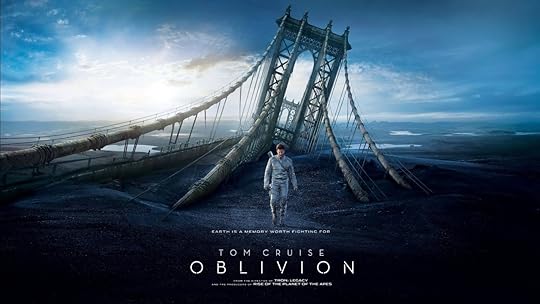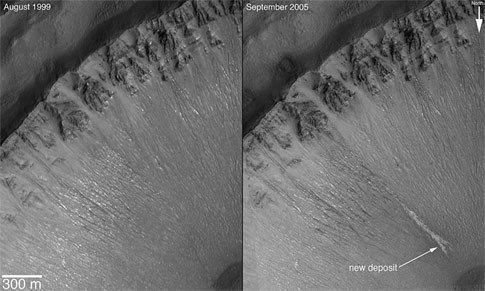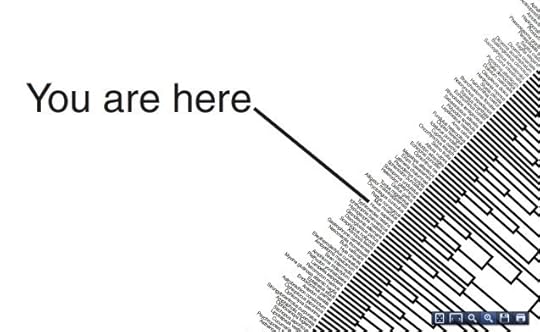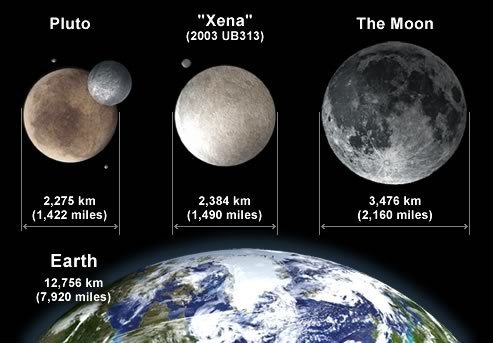Peter Cawdron's Blog, page 17
May 17, 2013
Into Darkness
I’ve been a bit too critical of the Star Trek reboot by , and have been debating the merits of the original trek movies and the revised franchise with Bruce Simmons of Brusimm’s book, movie & TV review blog. As much as I hate to say it, I think he’s right in that I’ve let nostalgia blur my recollections of Shatner and Nimoy, as the new take on Star Trek is different and has merit in its own way, without being slavish to the past. In light of this, I asked Bruce if he’d do a guest post on Star Trek Into Darkness (spoiler free), and he has put together the following review.
~~~
Star Trek Into Darkness is the 2nd movie in the J.J. Abrams reboot realm of the Gene Roddenberry sci-fi franchise. Chris Pine, Zachary Quinto, Zoe Saldana, Karl Urban, Simon Pegg, Anton Yelchin and John Cho reprise their roles while Benedict Cumberbatch (who has a very cool voice), Peter Weller and Alice Eve add their names to the franchise in one fashion or another.
J.J. Abrams directed and produced the movie off a story from Roberto Orci, Alex Kurtzman & Damon Lindelof.
With such an all-star cast, the question isn’t will the actors bring their characters to life in an entertaining fashion, the question is will this movie fall into the typical sequel realm of so-so, or does it hold up on its own, or stand out above the first one?
 To be honest, Star Trek Into Darkness is an oustanding sequel, a well done story, and this life-long Iron Man fan even liked this Abrams new Trek chapter better than he liked Iron Man 3.
To be honest, Star Trek Into Darkness is an oustanding sequel, a well done story, and this life-long Iron Man fan even liked this Abrams new Trek chapter better than he liked Iron Man 3.
One gem about the movie is that one does not need to be a fan to like the movie and the tale it tells. In fact, it was so fun, that the PG-13 rating is actually appreciated and the 132-minute runtime is not noticed.
The movie starts out in a whirlwind of opening stories.
One story involves watching Kirk (Pine) and Bones (Urban) and Spock (Quinto) trying to do a good deed. I say trying! But I can’t say much more without giving it away.
Another story thread shows a distraught set of parents hovering over their sick child. Cumberbatch’s character, “John Harrison,” beckons to them by offering a cure that no other scientist can provide. But in return, dad is employed (or coerced) into doing a dasterdly deed for our villian.
Our next story thread shows Kirk getting a lecture from Pike (Bruce Greenwood) on something he did wrong. It’s Kirk, after all, and somethings don’t change regardless of reboots, as I’m sure you can imagine.
And the journey goes from there. And oh, what a journey.
 This movie covers so much content, with a mature story, wonderful explorations of Kirk and Spock’s characters, Uhara’s (Saldana) relationship with Spock, some surprisingly strong emotional moments and a few homages paid to the original series and movies. (Also, the history we know from the original franchise is never forgotten in this reboot of Abrams in moments here and there.)
This movie covers so much content, with a mature story, wonderful explorations of Kirk and Spock’s characters, Uhara’s (Saldana) relationship with Spock, some surprisingly strong emotional moments and a few homages paid to the original series and movies. (Also, the history we know from the original franchise is never forgotten in this reboot of Abrams in moments here and there.)
The epic action is not over-the-top, but rather, seemingly well interspersed throughout this great story and movie experience.
One thing of note to keep an eye out for: Despite Spock being the non-emotional character, there are some wonderful moments that Zachary Quinto delivers with just his eyes, as he shows the inner turmoil of his struggles with logic versus emotion. Quinto brings a whole new level to the character I never thought I’d see.
I think this is one of the first times I’ve actually ever appreciated a PG-13 movie rating. I say that because despite the opportunity to show graphic levels of gore, J.J. Abrams still suggests some wicked action, but avoids needing to show it, and avoids ruining the energy of the scene. Implied gore is good enough because I love using my imagination to presume my own, personal comfort level of gore.
If you’re a Trek fan, go see Star Trek into Darkness. If you’re not a Trek fan, go see the movie anyway. It’s a wonderful story that does not need an intimate knowledge of the Trek franchise to enjoy.
This review provided by Bruce Simmons


April 24, 2013
Phantom Menace
 A long time ago, in a cinema not too far away, George Lucas complicated things by releasing The Phantom Menace, the first in a series of three prequels that transformed the Star Wars trilogy into a hexalogy, and, yes, that’s a real word.
A long time ago, in a cinema not too far away, George Lucas complicated things by releasing The Phantom Menace, the first in a series of three prequels that transformed the Star Wars trilogy into a hexalogy, and, yes, that’s a real word.
Star Wars is iconic, but it is not beyond reproach, and with a reboot or extension in the works for 2015, I thought it was worth looking back at The Phantom Menace to see what worked well and what didn’t.
Who doesn’t love a good light-sabre duel? The Phantom Menace has arguably the best sword fight in the series, and yet The Menace is widely regarded as the worse of the Star Wars movies.
The Phantom Menace is an enigma. I’m not sure anyone knows quite what to do with it. Empire magazine rated it as one of the greatest movies of all time, while Entertainment Weekly considered it one of the worst sequels/prequels ever made.
With a new Star Wars movie slated for 2015, I thought it would be interesting to look at the highs and lows of The Phantom Menace.
OK, lets get the lows over with as quickly as possible…
What was it with Jar Jar Binks and the whole racial overtones of the Caribbean-like Gungans? Not to mention the frugal, angry Jewish stereotype in Watto.
“Me’s a thinks he’s a insulting deem dat donna speaka American as dear first language.”
There’s only one possible explanation for Jar Jar Binks, and it’s the same as for the Ewoks: George was trying to market a cute and cuddly toy for kids. And that’s no surprise, as George has made twenty billion dollars on the back of merchandising. One only wishes it had been money well spent on things other than Jar Jar.
Between Jar Jar Binks, the morally bankrupt position of putting a nine-year old in a life-and-death pod race, and an anorexic army of incompetent robots, The Phantom Menace skirts with disaster.
The redeeming factors in The Phantom Menace are that we get our first glimpse of a fully qualified Jedi Knight and the breathtaking contrasts in exotic settings.
When Star Wars first hit the silver screen in 1977, it was the opening minute that whisked me away into another galaxy: A rebel cruiser flew over a desert world, taking fire from some unseen pursuer, and then the theatre started to shake as a Star Destroyer slowly filled the screen. That there was no sound in space was the furtherest thing from my mind, it was the audacious scale of the adventure that caused me to suspend my disbelief.
The original Star Wars (sorry, I can’t bring myself to call it episode IV) was breathtaking because of the scope of its vision. From a battle in space, to a desert planet, from a cantina full of strange aliens, to the inside of the Death Star and on, Star Wars was a swashbuckling adventure.
And that’s where The Phantom Menace succeeds. In the Menace, we see trade federation battleships, the idyllic planet Naboo, the 50s style retro spaceships of Queen Amidala, the desert world of Tatooine and the city-planet of Coruscant. And it’s these sweeping locations that anchors the sense of adventure.
But perhaps the most iconic aspect of Star Wars is the light-sabre.
And when it comes to The Phantom Menace, the swashbuckling, high-seas adventure was reinforced with a dual of epic proportions.
Star Wars has always been about the battle between good and evil, and nowhere is this more vividly displayed than in the face of the devilish Darth Maul. The powerplays and intrigue surrounding the Sith wasn’t always believable but it did add an element of depth to the story.
If anything, this antagonist was killed off too soon. Although it’s worth noting that in the animated series The Clone Wars, Darth Maul survives and is given robotic legs so as to continue his demonic quest.
When it comes to the reboot of Star Wars, or its continuation, or whatever happens to the story in 2015, I hope the screenwriters, producers and directors look carefully at what worked and what didn’t in movies like The Phantom Menace.
In 2009, Star Trek was rebooted and although we gained a heart-pounding, adrenalin-filled action/adventure story, we lost the concept of boldly going where no one had gone before. Instead of the excitement of discovery, we were given Mission Impossible in space. Not that this is a bad thing, but it does detract from the original intent of Star Trek (ie, the trek into the unknown).
When it comes to Star Wars 2015, I hope we don’t get Mission Impossible with light sabres. Star Wars has so much richness and so many possibilities left to explore. The Phantom Menace gave us a glimpse of what was possible, and I hope the new movies continue the swashbuckling adventure with style and aplomb.


April 11, 2013
Oblivion
io9, a popular science fiction blog, recently reported on nine separate movie reviews that describe the movie Oblivion as lifeless, but they’re wrong.
Oblivion is an intelligent, thoughtful, well-plotted movie with liberal doses of suspense, tension and action. Sure, there’s a couple of minor plot holes, but for me it was 9/10 and can be forgiven for a few trivial issues.
Put your popcorn down. Stop slurping on your frozen coke. You can’t switch-off and zone-out during Oblivion. You’ll have to pay attention to the subtleties, right down to the lyrics of a 70s rock song playing softly in the background, but it will be worth the effort.
This is no movie for 7th graders. Oblivion won’t spell out the plot for you, but all the clues are there if you pay attention to the details, and before long they’ll become blisteringly obvious.
Personally, I cringe at the association between Tom Cruise and the Church of Scientology, but, damn, can that boy act! He doesn’t look, sound or move like a fifty year old. Sure, there’s the typical Cruise mannerisms, but they don’t overplay the character and he fits seamlessly into the role of a droid technician.
The scenery is stunning, the panoramas breathtaking, and the story is paced to match, with just the right balance of intrigue and character development.
If I have one criticism it would be that they give too much away in the trailer, and this is a trend we’re seeing across a lot of movies lately, including Star Trek Into Darkness. When it comes to Oblivion, the haunting beauty of the shattered landscape would have been better served as a surprise. The producers could have held back on releasing so many “money shots” in the trailer without losing out on audience attendance. Trailers should be teasers, not a compressed short for the entire movie minus one or two plot points.
If you’ve enjoyed books like Galactic Exploration you’ll love Oblivion.


April 3, 2013
My favorite martian
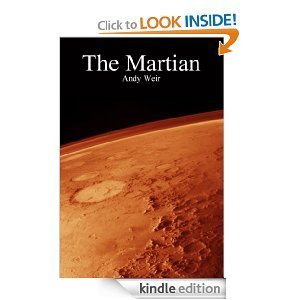 No… it’s not a low-budget 60′s TV show, it’s a 99c ebook called The Martian by Andy Weir, and it’s been optioned by Fox as a possible feature-length movie.
No… it’s not a low-budget 60′s TV show, it’s a 99c ebook called The Martian by Andy Weir, and it’s been optioned by Fox as a possible feature-length movie.
Paulo Ribeiro put me on to this little nugget of a book.
At first, it didn’t work for me. I read the opening chapters and found it a hard slog, but once the book found its rhythm the story moved along quite nicely and with enough twists and turns to maintain a sense of intrigue.
The story revolves around Mark Watney, an astronaut on the second expedition to Mars, a mission with a 30 day stay on the planet’s surface. During a freak storm, he’s injured and left for dead by the crew as they rush to escape before high winds tip their MAV (Mars Ascent Vehicle).
 In reality, within the thin Martian atmosphere, even hurricane-like storms with winds of 120mph will feel like a summer breeze on Earth. There’s just so little atmospheric mass.
In reality, within the thin Martian atmosphere, even hurricane-like storms with winds of 120mph will feel like a summer breeze on Earth. There’s just so little atmospheric mass.
Most of the Martian dust is as fine as cigarette smoke or talcum powder.
For the sake of the story, though, it’s conceivable the MAV was built from lightweight, thin, sheet-metal to save on fuel (like the ascent stage on the Lunar Module), and poor design meant it acted as a sail, catching the wind. Or perhaps the MAV landed on uneven ground and the wind exasperated an already existing lean.
If NASA used the classic large landing pads seen on Apollo, though, with legs spread out broadly to increase stability, then the real danger from the storm wouldn’t be the wind tipping the MAV, it would be grit clogging the engine lines or erosion wearing through the insulation layers and rubber seals as the craft was effectively sand blasted by the Martian hurricane.
In any regard, Mark is stranded, and here’s where the story kicks off. Alone, with no means of contacting Earth and meagre supplies, Mark’s got to figure out how he can survive for roughly three years before the next mission arrives.
Mark Watney’s first task is growing potatoes and, honestly, this had me give up on the book for several weeks. Although it’s plausible, the writing at this point is like a long-winded question from a mathematics exam for 12 year olds. Unless you have a calculator handy and are passionately interested in running the sums, it becomes a bit tedious going through so many different scenarios.
I lost interest.
Paulo loves this book, and his enthusiasm encouraged me to give it a second go, and I’m glad I did.
As tedious as those calculations/scenarios are, an astronaut in that predicament would have to be that tenacious and resourceful to survive. I’m fairly certain he’d never eat another potato in his life once back on Earth, but on Mars, he’d have to do whatever it took to stay alive.
Beyond this point, the book kicks up a gear and the interest builds as the story expands. There’s highs and lows, there’s well-worked plans and unexpected disasters, there’s contact with Earth and humorous anecdotes, and the writing keeps you wanting to learn more about this celestial Robinson Crusoe, this Martian MacGyver. By the end, I was racing through this book, not wanting the story to stop.
Author Andy Weir has a wonderful grasp on the kinds of challenges a stranded astronaut would go through and the depth of thinking NASA would apply in such a scenario, and that makes the book fascinating to read.
At a buck, you can’t go wrong with The Martian. You’ll spend twice that on the next rubbishy candy bar you buy, and how long will that last? It won’t be as enjoyable or as healthy.
Anyway, if you’d like to idle away your time exploring the Acidalia Planitia on Mars, you’ll enjoy this plausible, lighthearted ebook.
And as for the movie, I’ll be lining up for tickets on the opening night 


March 25, 2013
Is there life on Mars now?
NASA’s Mars Curiosity rover is still in the infancy of its exploration of Gale crater, but already there’s some tell-tale signs that support the idea that Mars was radically different in past aeons.
Mt Sharp dominates the interior of Gale crater and is the focus of Curiosity’s exploration over the next few years. Pictures can be deceiving, with 18,000 feet in elevation, Mt Sharp is higher than any of the Rocky Mountains.
Mt Sharp is all the more remarkable because it has been formed as the result of geological uplift and erosion.
Look at the separation between the oldest sedimentary layers in the lower half of this image, dating back billions of years, and the uplifted/tilted and yet still parallel sedimentary layers in the younger, upper section. Younger, being a relative term here, as these layers would date back hundreds of millions to billions of years as well, and all of this is laid down before the slow process of erosion reveals what we see today.
If there has ever been macroscopic life on Mars, this is where we’ll find fossil evidence for it, as the planet’s history is revealed here in a geological timeline stretching back billions of years, but what about life now? Could there be some form of life on Mars right now?
We looked at Mars today as a dry, inhospitable desert planet, something like the planet Tatooine from Star Wars, but Mars is more akin to the frozen deserts we see in countries like Chile and Canada, only drier and colder.
Mars has an absurdly low atmospheric pressure.
Temperatures on Mars can be as low as -125F (-87C) and rarely get above 32F (0C), but that’s not the worst Mars has to offer. Even if the Martian atmosphere was breathable (which it isn’t) the air pressure is only 8 millibars (6mmHg), which is what we experience on Earth at 100,000 ft (31,000M).
The average atmospheric pressure is so low on Mars that if you stood outside with a cup of cold water it would boil away in front of you even though its temperature remained near freezing.
With the surface of Mars bathed in solar radiation and toxic CO2, Mars is hostile to life, right?
Well, yes and no… Although this dessicated environment would be hostile to multicellular life, there are bacteria on Earth that consume CO2, can live in sub-zero temperatures (although not to these extremes) and can survive in such a thin atmosphere.
 Autotroph is the term used for organisms (bacteria, plants, etc) that produce complex proteins, fats and carbohydrates from inorganic molecules in their environment, using either photosynthesis or chemosynthesis for energy. And we’ve found bacteria at altitudes of up to 50,000 ft (15,000M), so microbes from Earth would struggle to survive on Mars, but their task would not be impossible.
Autotroph is the term used for organisms (bacteria, plants, etc) that produce complex proteins, fats and carbohydrates from inorganic molecules in their environment, using either photosynthesis or chemosynthesis for energy. And we’ve found bacteria at altitudes of up to 50,000 ft (15,000M), so microbes from Earth would struggle to survive on Mars, but their task would not be impossible.
Here on Earth, we’ve found microbes thriving well below the surface of the planet.
Scientists recently retrieved bacteria three-quarters of a mile beneath the sea floor, reaching into a geological strata known as the gabbroic layer, something that’s significant not because of its depth, but because this is the last, lowest layer of the Earth’s crust before reaching the mantle.
Another microbe, Desulforudis audaxviator, was detected in water two miles beneath the earth within a South African gold mine.
Desulforudis audaxviator relies only on hydrogen and sulfide for food, derived from the breakdown of uranium and other radioactive elements. It’s an evolutionary hermit, having adapted to survive without the sun or oxygen, independent of any food chain. This remarkable microbe comprises an “ecosystem of one.”
And all this raises the stakes for the kind of life that could still flourish on Mars, albeit in dried up lava tubes or in the Hellas basin where higher local air pressures allow liquid water to exist close to or even on the surface, and temperatures can reach a respectable 60F (10C).
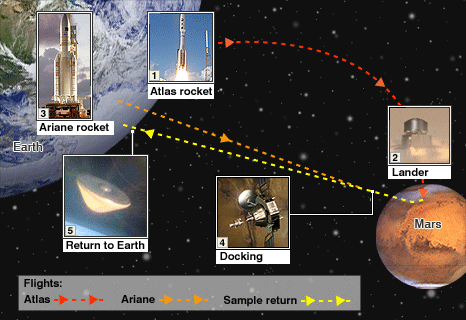
The Mars Sample Return mission is slated for 2018, but even with a two-stage return, the mission will only bring 500g of soil back to Earth. When you’re spending eight billion dollars for just over a pound of Martian soil you want to make sure you’re not bringing back beach sand.
In the Martian summer, it’s common to find water flowing out from crater walls. Such unstable ground would be difficult to negotiate, but a sample from here just might be worth eight billion dollars if it reveals life on Mars.


March 16, 2013
The little story that could
 In 2011, Hugh Howey had just finishing a college writing course in science fiction. After submitting his final project, he wanted to let his brain “purge” and unwind and so started writing Wool.
In 2011, Hugh Howey had just finishing a college writing course in science fiction. After submitting his final project, he wanted to let his brain “purge” and unwind and so started writing Wool.
Rather than writing to please others, or to craft something that was cliched, marketable and safe, Hugh wanted to write a story he’d personally like to read, and that’s what makes Wool so enjoyable.
Little did Hugh know when he finished that first short story just how far the story would go and where it would take him. Hugh expanded Wool into a character-driven dystopian novel where authoritarian structures are brought down by those with the courage to think for themselves.
Now, Hugh has an international best seller that’s had movie rights optioned to none other than Ridley Scott. Wool has a phenomenal 3,876 reviews, with an average rating of 4.8 stars.
Wool is the little story that could.
And the surprising thing is, in the history of science fiction, it’s often the novellas and the short stories that make it big. Consider these classics
I Am Legend
Minority Report
Do Androids Dream of Electric Sheep (Blade Runner)
Ender’s Game (which like Wool was expanded into a novel)
We Can Remember it for you Wholesale (Total Recall)
Who Goes There? (The Thing)
I, Robot
Enemy Mine
Bicentennial Man
Johnny Mnemonic
A Sound Of Thunder
Like the original Wool, all of these are either short stories or novellas, there’s not a novel among them.
As a writer, I find this fascinating as it dispels the myth that readers are only interested in full length novels, that if it’s not a novel it’s not worth reading. Nothing could be further from the truth.
In light of this, I’ve made my novella Trixie & Me available free on Amazon. It too is a little story chugging up the literary hill.


March 1, 2013
You are here
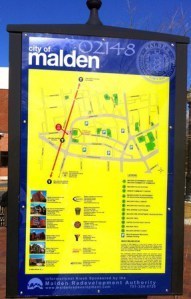 Have you ever been lost in a mall? Or perhaps trying to find the right stop in a subway? Or lost in some giant theme park? If you have, you’ve probably come across one of the ubiquitous “You are here” signs.
Have you ever been lost in a mall? Or perhaps trying to find the right stop in a subway? Or lost in some giant theme park? If you have, you’ve probably come across one of the ubiquitous “You are here” signs.
And they help, right?
If you’ve lost your way, it’s helpful to know where you are so you can figure out where you want to go.
Over the past five hundred years, science has produced a number of astonishing “You are here” signposts for humanity, documenting our position in the universe, putting life in perspective.
In the 1500s, Copernicus struggled to make sense of the confusing motion of planets moving around Earth and, in a stroke of genius, realized there was a simple solution.
Copernicus realized the problem was one of biased perception, as soon as the Sun was placed at the center of the Solar System, the orbit of the planets became roughly circular and much simpler to calculate.
It all seems rather obvious to us today, but think about how counterintuitive this notion is. Five hundred years later, we still talk about sunrise and sunset even though we know it’s Earth that rotates to form a day. Somehow, the concept of a “romantic Earth turn” is not likely to replace the term sunset any time soon.
And science has continued to redefine our view of the universe around us.
Not only does Earth spin on its axis as it orbits the Sun, but the Sun is in motion as well. Our Sun orbits the Milky Way galaxy once every 250 million years. The last time we were “here” dinosaurs were standing in your living room.
And “here” is quite a concept when you stop and consider all it took to get here.
But finding our place on the map doesn’t just stop here with time and space, science has also redefined our place in biology.
Homo sapiens are part of the phylogenetic tree of life, a beautifully intricate, interrelated web of life stemming from a common origin billions of years ago. As Charles Darwin first appreciated, Natural Selection has shaped the evolution of life on Earth, leading to our lives today.
Perhaps a close up of this particular map will help put things in perspective.
Yes, that’s you (and me), right there, sandwiched between Mus musculus and Typhlonectes natans, squished between mice and eels.
Yup, that’s correct, even at this scale we’re still struggling to zoom in close enough to see our closest relatives on the tree of life, the great apes (including chimpanzees and the like). At the top right, you might just be able to make out sagitta elegans, a species of planarian worms barely a millimetre or so in length. We’re all related, far more so than anyone before Darwin dared to imagine.
Knowing our place in both time and space, in biology and in cosmology, is humbling, and yet it also puts us in a remarkably unique position. Of all the species on Earth, only Homo sapiens has the mental accumen to appreciate the wonder of life.
In 1990, Voyager 1 took a photograph of Earth from a distance of six billion miles, or five and a half light-hours away. The original NASA photograph has 640,000 pixels in it, of which Earth comprises 0.12 of a pixel. At that distance, we’re barely a full stop. Inspired by this image, Carl Sagan wrote the following in a book called the Pale Blue Dot.
If you get lost in life, remember the astonishing position you hold in this beautiful universe.


February 14, 2013
Is Pluto a planet?
Is Pluto a planet?
My heart says yes, my head says no.
Pluto is an oddball, of that everyone can agree, but is it a planet?
At first glance, the concept of a planet seems pretty straight forward: Big round thingy swinging around a star, but there’s more to it than that, as there’s lots of stuff orbiting stars, including comets and asteroids.
Pluto’s small on the planetary scale, and therein lies the problem.
Pluto is smaller than our Moon. In fact, Pluto is smaller than several other moons in our solar system, including Titan.
In addition to this, there are several other objects in the Kuiper belt, like Eris (), that are the same size as Pluto or larger and we don’t consider these planets.
If we compare the circumference of Pluto with Neptune, Pluto is 21x smaller. If we compare the estimated mass, then Pluto is almost 8000x smaller than Neptune.
And yet comparisons are a slippery slope. If we make the same comparison between Earth and Jupiter, then Earth’s circumference is 10x smaller than our Jovian giant, while Earth’s mass is an astounding 320x smaller, so does that make Earth a dwarf planet? It’s a good question when you think about it.
The International Astronomical Union (IAU) struggled with Pluto’s planetary designation for over a decade before finally relegating Pluto as a dwarf planet.
According to the IAU, a planet is:
is in orbit around the Sun
has sufficent mass to assume hydrostatic equilibrium (basically a round shape)
has “cleared the neighbourhood” around its orbit
The problem with this definition is:
we’ve detected rouge planets that don’t orbit any star and yet are still decidedly planets
even Earth hasn’t cleared out its neighbourhood, with plenty of trojan asteroids loosely in orbit around our humble abode
Regardless, the IAU decided that Pluto’s inability to clear out its surroundings and its disproportionally large moon Charon, disqualified it from planethood (if there is such a term) and so Pluto was designated a dwarf planet.
Truth be told, even that category is generous, and leans more on the historical position of Pluto than it does on any of Pluto’s physical characteristics.
Pluto is a cosmic iceberg.
As best we understand Pluto’s composition at this time, Pluto doesn’t have the iron core we associate with regular planets and is probably a mixture of rock and ice.
Given its composition and its highly irregular orbit, which is tilted by 17 degrees relative to the rest of the planets and how Pluto’s orbit cuts inside the orbit of Neptune from time to time, NASA even suggested Pluto may be a “failed” dormant comet. “Failed” in that it never got close enough to the Sun for its volatiles to give it a distinct comet tail.
Had Pluto fallen into an orbit that took it into the inner solar system it would have been the most spectacular comet of all time. And being accompanied by its icy moon Charon, Pluto would have had a highly irregular coma that may have appeared to vacillate over a period of six days (being the orbital period of Charon).
Pluto might not make much of a planet, but it would have made a sensational comet had its orbit taken it closer to the sun.
If you’d like to learn more about Pluto, check out Vintage Space.


January 26, 2013
On a rainy Sunday afternoon
JJ Abrams is credited with reviving the Star Trek franchise with his reboot and has been given the reins of the new Star Wars movies.
As much as I enjoyed the action in his depiction of Star Trek, it lacked the finness of the Shatner epics. No longer are we boldly going where no one has gone before, we were retracing steps in an alternate universe. The roller-coaster is more important than the narrative.
When it comes to a Star Wars reboot or Star Wars extension or whatever it turns out to be, I hope Abrams captures the awe and essence of the original, the local boy who makes good, triumph over evil kinda story. Light sabres and space battles are not enough.
Anyway, the wind is howling, the rain is falling and I’m on my second cup of hot chocolate, so it’s time for some short science fiction movies to enjoy on a quiet Sunday afternoon.
You can find hundreds of these movies on the net. Most of them are fan fics, essentially paint-ball fantasies with no real merit beyond nice special effects. Others, though, have some finness that even the likes of JJ Abrams could learn from.
There’s some astonishing talent in the composition and production of these movies. Character tends to take a back seat, but, hey, they’re working with a very strict, compact medium so that’s no surprise.
The Gate is a little Resident Evil, but fun nonetheless. It’s a bit of a luddite, fear-the-future movie, but hey, as 1984 has taught us, that’s a good way to ensure such a future never unfolds.
The Device is awesome… be careful what you wish for.
The Hunt for Gollum is a prequel to Lord of the Rings: Fellowship of the Ring and explores the backstory behind how Aragon came to be waiting for the hobbits at the Prancing Pony Inn. There’s a couple of canonical inconsistencies, and it’s tough gig filling in for Viggo Mortensen and Ian McKellen, but the acting and cinematography in this fan tribute are simply brilliant.


January 25, 2013
Monstrous Reviews
Reviews are a bit paradoxical for writers. Everyone wants to hear praise, but there’s learning in every review, even the one stars. And make no mistake, all books end up with one star reviews. There’s just so much diversity between readers.
Recently, Amazon has come under fire to clean up its reviews as some authors “seed” their books with fake reviews to boost sales.
I take reviews seriously, as they’re supposed to be an independent opinion on a book. I’ve given away books with a request for a review and received some honest critiques, but I’ve never paid for fake reviews.
Reviews are the lifeblood of an independent writer, as readers look to reviews to understand whether they’ll enjoy a particular book themselves. But perhaps the most interesting aspect of reviews is when readers provide their own insights based on what they’ve read.
In this regard, I’ve had some monstrous reviews of Monsters on various private blogs, Goodreads and Amazon (monstrous meaning massive, not terrible). Here’s some highlights that caught my eye, not because they flatter the book, but because they offer keen insights into the topic the book covers.
[Monsters is] a devolved dystopian novel that doubles up as a love letter to literacy and knowledge. After a near miss with a comet has some catastrophic events, including a drastic increase in size of many of the planet’s fauna, Earth is plunged back into the dark ages. Books, science and knowledge are shunned, and literate people are tortured and killed as examples to others. Yet some struggle to learn…
One of the things we take for granted is our ability to read and educate ourselves… I really loved the premise of this novel, and how in this post apocalypse world, knowledge and reading is likened to witchcraft
To fear and disdain science is one of the worst mistakes that a society, any society, could make. The only reason that we are who we are as a species is that we have used our intelligence to understand the universe around us and to devise ways to survive despite our inherent physical weaknesses. Compared to many other organisms on this earth of ours, we are not very big, very fast, or even moderately strong. We do not have sharp fangs or strong claws. Nonetheless, we have tamed the planet; heck, we have gone to space, we have walked on the Moon! And again, the only reason why we have been able to do so is through science and technology.
… the theme for this book … is really how much would we lose if we as a civilization lost the ability to read and how would our lives be affected through the generations… [I] hated to see [the book] end. If I had to be in this world I would surely take the risks that the characters do to get their hands on books, because I too am a reader.
More than just a book about post apocalyptic societies and the rise of nature to overcome man, Monsters is about the power of knowledge… the discovery of knowledge not only scares those in power, but it can bring down a dictator.
[Reading is] a secret liberty … an individual freedom, an artistic expression … reading is a relatively modern phenomenon and, throughout history, reading has usually only been reserved for the privileged. [Cawdron] touches on the terror of things we take for granted, like basic medical treatment, and it makes you think about what we have now … there’s a ton of room for a great sequel or a smart prequel as apes take over the … oh, sorry, wrong franchise
To everyone that’s provided their thoughts on any of my novels, from one star through to five, thanks for taking the time to read and review.
You can find Monsters on Amazon







